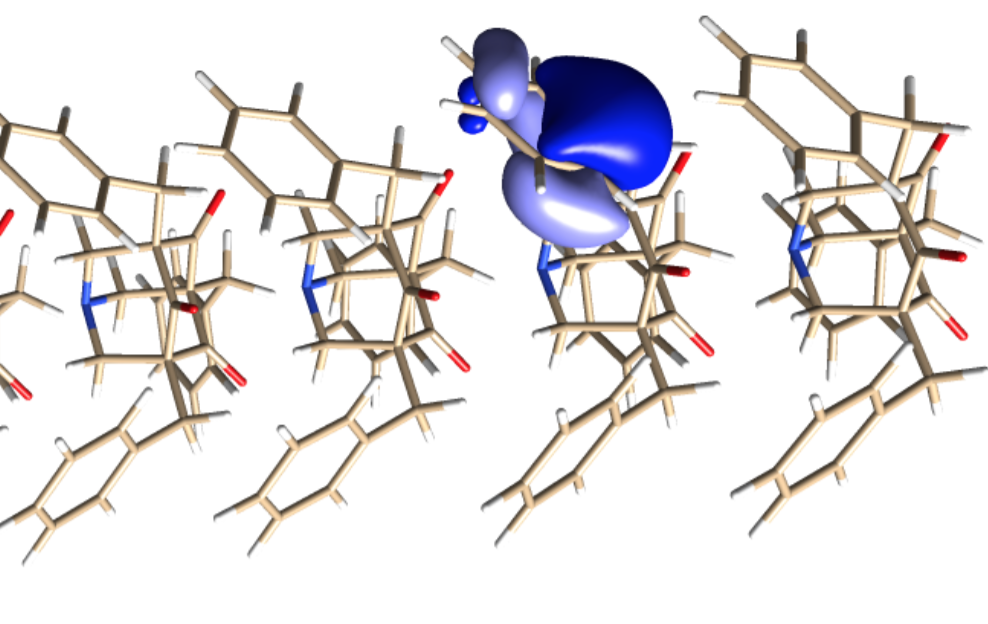Now on ASCR Discovery: Super Wires

Computational chemists have made strides modeling many complex chemical interactions, thanks in part to massively parallel computing and algorithms that approach predictive accuracy. But even the best methods trade off between atomic-scale accuracy and simulating how thousands of atoms behave. No chemistry simulation has accounted for the attraction and repulsion of each molecular orbital because the job has been too computationally demanding.
Bridging this gap has been high on the to-do list for computational chemists worldwide, including a collaborative group from Denmark and Oak Ridge National Laboratory. Computational chemists, led by Poul Jorgensen of Aarhus University, are using the Titan supercomputer at the Department of Energy’s Oak Ridge Leadership Computing Facility to break computing records for modeling a molecular nanowire system containing thousands of atoms.
The research, with support from a DOE Office of Science Innovative and Novel Computational Impact on Theory and Experiment (INCITE) award, involves a class of molecules called supramolecular wires – nanoscale filaments that self-assemble in solution from subunits and are cemented by local interactions among electrons in the subunits.
These intermolecular forces arise when individual electrons temporarily become unbalanced in an atom and form a fleeting positive or negative charge that can attract or repel a nearby atom. Known as van der Waals forces, they’re often described in chemistry textbooks as the weakest molecular forces. But among the chemical interactions that occur in a supramolecular wire assembly, weak forces are critical.
The supramolecular wire system thus provided a perfect test case for the experimental Divide-Expand-Consolidate (DEC) coupled-cluster (CC) numerical scheme, says Jacek Jakowski, an Oak Ridge computational chemist and one of the INCITE investigators. Since the calculations involve local interaction among electrons, they were amenable to division into lots of smaller calculations, as the DEC scheme was designed to do. And in contrast to the well-known density functional theory (DFT) algorithms typically used to model large molecular systems, the coupled-cluster (CC) numerical method incorporates these weak forces into its energy calculations.
The group simulated a supramolecular wire composed of 1-azaadamantane-trione (AAT) monomers. Azaadamantanes have asymmetrical ends that act as electron donors and receptors attracting each other into LEGO brick-like nesting configurations to form linear supramolecular wires.
“We are interested in understanding how these molecules assemble in solution and how the process of assembling can be controlled and directed,” Jakowski says. “These molecules have interesting electronic properties and are candidates for electronic and opto-electronic applications, such as organic light-emitting diodes, electric rectifiers and electro-optical modulators.”
The DEC strategy recently set a world record for this kind of simulation, modeling up to 40 monomers (2,440 atoms). The model kept 14,952 of Titan’s 18,688 nodes occupied for almost 19 hours, says a research report submitted to the prestigious Gordon Bell competition at the SC16 conference this fall in Salt Lake City. These calculations, which describe individual molecular orbitals, are well known but have never been modeled on such a large molecular system.
The key to achieving the computational breakthrough was dividing the molecular system into smaller fragments that could be calculated separately in the massively parallel computer and then recombined.
Read more at ASCR Discovery, a website highlighting research supported by Department of Energy’s Advanced Scientific Computing Research program.
Image caption: A segment of a supramolecular wire with molecular orbitals (purple) highlighted. Image courtesy of Thomas Kjærgaard, Department of Chemistry, Aarhus University, Aarhus, Denmark.


